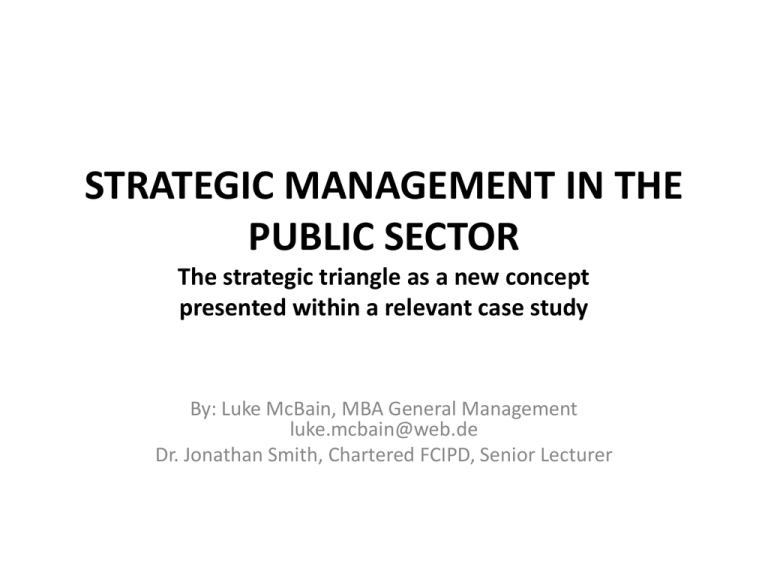STRATEGIC MANAGEMENT IN THE PUBLIC SECTOR A new
advertisement

STRATEGIC MANAGEMENT IN THE PUBLIC SECTOR The strategic triangle as a new concept presented within a relevant case study By: Luke McBain, MBA General Management luke.mcbain@web.de Dr. Jonathan Smith, Chartered FCIPD, Senior Lecturer Concepts and theories impacting public management • – Growing complexity of social problems – The growing demands of citizens – Acceleration of social change • Formulating policy The challenge today: Solution of 80ies: „New Public Management“ Setting objectives Political rationale Evaluation of outcomes – Private sector principles and tools • Enrichment in 90ies: Perspective of „Governance“ – Shaping and optimizing of the interdependencies between actors in a society which cooperatively attempt to produce public value • Today: Public administration as a partner of politicians in the definition of what value should be created in what way Quantifiying objectives Implementation of objectives „Translation“ Documentation of outcomes Management rationale Attainment of objectives Operations Strategic Management in the Public Sector 2 Concepts and theories impacting public management The rational planning model seems to be unrealistic in the face of complex social interaction What is actually happening in public management? “Satisficing” “Management of muddling through” (Mayhew, 1974; Bogumil & Jann 2009) (Lindblom, 1959) “Logical incrementalism” (Quinn, 1980; Quinn & Voyer 1994) … cross cutting themes in all steps of strategic management in the public sector and convey the importance of negotiation and bargaining 3 Characteristics of the public sector shaping strategic management The authorizing environment and the interdependent actors can be considered the actual market of the public organization, further factors impact strategic management: • Environmental factors – Influence of the political level – Legal mandates • Transactional factors – – – – – • Coerciveness Scope of impact Public scrutiny, accountability Collective ownership Management must include societal values such as fairness, openness, inclusiveness, honesty Factors in the organization – Goal setting processes are conflicted – Measuring performance complex and difficult Strategic Management in the Public Sector 4 Characteristics of the public sector shaping strategic management Impact on the models available to strategic management : – Strategy as positioning or scope: The more public an organization is, the more it will have to position itself within the authorizing environment as its “market” in terms of producing outcome and adjusting its scope. – Strategy as setting long-term direction: Due to the turbulent nature of the authorizing environment a core unit of the state will have more difficulty in setting long-term direction than a more peripheral one which delivers concrete products and services. – Strategic fit … …can be seen here by maximizing public value while at the same time attracting a maximum of permission and resources. This might lead to trade-offs between what is perceived valuable and acceptable to the political environment. – Strategy as stretching competencies: Not only must the public manger use internal capabilities but rather rally support from coproducers and external actors, which means that the organizations strategy must be attractive enough for outside actors. Strategic Management in the Public Sector 5 The strategic triangle A new approach to strategic management in the public sector: The strategic triangle (adapted from Moore, 1995) Three three main management dimensions Key person: Head of department responsible for all three dimensions of strategic management (Managing up) Political management Political support as “… an axiomatic principle of public sector management.” (Managing outward) (Managing down) Cooperation management Collaboration, coproduction and networking between social actors Key persons: Middle management main responsibility for cooperation and operations management Operations Management Strategic Management in the Public Sector Maximizing efficiency and effectiveness Key persons: Staff main responsibility for operations The Case: The Training Centre for Development Cooperation (V-EZ) V-EZ, the department 8 of InWEnt –Capacity Building International: • • • Human resource and capacity building institution in the field of development cooperation Public utility limited liability company financed by the Federal Ministry of Economic Cooperation (BMZ) Offers training courses in the areas of: – Intercultural competencies and country specific orientations – Development policy – Consulting and management competencies – Language – Specific training for partners and spouses of ex-pats 2008: Over 1.700 participants trained Budget of 3.9 m Euro Current mandate: “Preparation and training for international deployment of experts in development cooperation”. Since 2005 the V-EZ has given itself new strategic aims: 1. Expansion of preparation towards international human resources development 2. Expansion of customer groups (cross-departmental, private sector) 3. Internationalization / European focus (trainers, offers, partnering with 7 international training centers) The Case: The Training Centre for Development Cooperation (V-EZ) Chronology of events in a tactical time line Process standardization and centralization (analysis) Modularization Development policy curriculum New course structure New departmental structure Strategy formulation Building internal competencies Adapting acquisition objectives Change in marketing stance Focus on meeting acquisition objectives 2005 2006 Extension of mandate meets resistance 2007 Division coordination structure implemented Capacity Competencies Communication Infrastructure Sick leave division manager “Strategy rests” Staff changes Elections Financial crisis Formulation of new marketing strategy Personnel fluctuation From extension of mandate to ‘Modern Preparation’ 2008 ‘Modern Preparation’ Pilots Innovation 2009 Mid-term Future Long-term Future The Case: The Training Centre for Development Cooperation (V-EZ) Main finding 1 VE-Z managed strategically very close to Quinn’s concept of “logical incrementalism” , blending intended and emerging strategy 1. The organizations' focus is on key themes or thrusts “Broad initiatives that can be flexibly guided in any of several possible desirable directions. “ (Quinn & Voyer 1998): “From training to HR development” & “From national to international” – – 2. “Tactical shifts and partial solutions” (Quinn & Voyer) – 3. These themes are communicated again and again and are well reflected in the answers given by respondents A setback in extending the mandate was offset by focusing of innovation and establishing international cooperations internal reform, quality management, process optimization, restructuring and standardization can be seen as a series of tactical adjustments to create organizational readiness “Experimentation (that) can occur with minimized risk” (Quinn & Voyer) – Current focus more on innovation and pilot projects Strategic Management in the Public Sector 9 Relevancy of the strategic triangle observed in the case Main finding 2 Political Management Management dimensions of the strategic triangle are interdependent Cooperation Management Operations Management Main finding 3 Difference in the dimensions impacting the formulation of strategy, the implementation and the adaption of strategy. In the formulation phase political management is dominant: • • • • • Strategy was formulated in alignment to international political developments, Millennium Development Goals in 2000 and the Paris Declaration in 2005 “Is the value we are producing significant enough to secure the future in light of internationalization of development cooperation?” Warding off threat of a further merger for InWEnt and the V-EZ (in 2010 imminent) Future needs and interests of the existing cooperation partners were anticipated by the organization. However: German cooperating partners were not as supportive of these new strategic aims This strategy can be labeled as “pro-active”. The organization is taking a “prospector” stance by seeking new markets and new alliances and creating new services (Miles & Snow 1978; Nutt & Backoff 1995; Boyne, 2004). Strategic Management in the Public Sector 10 Relevancy of the strategic triangle observed in the case Main finding 3 Implementation phase focuses on cooperation and on operations: • • • • • • German cooperating partners were not as supportive of new strategic aims Shift towards international cooperation partners Strategy was also adapted to the cooperation partners needs, which were anticipated or not Increased flexibility and new and higher quality services Competencies were seen not being matched with acquisition objectives, but also not with strategic aims. Surprising little adaption in implementation is due to political factors – The political landscape and the environment have not changed drastically since 2005. – Most respondents still see “securing the future” as one of the main themes to be dealt with strategically. – The division manager respondent to this topic: “When everything is going in a good way, we don’t hear anything from the political level.” Strategic Management in the Public Sector 11 Summary from case findings • • • • The management dimensions “political” and “cooperation” were dominant during planning The dimensions “cooperation” and “operations” were dominant during implementation and adaptation Looking into the longterm future, political factors dominate the strategy discourse Cooperation and operations dominate the mid-term and short-term time horizon Overarching vision and strategic themes achieved by: Long-term time horizon Political Management Interdependency of management activities Incremental expansion of value provided Value Operations Cooperation Management Management Mid-term to short-term time horizon Conclusions General conclusions • • • Building robust alliances internally and externally is the key to strategic success in the public sector The public manager of today is constantly challenged to provide answers for the constant development and readaptation of what and how of the organization Ownership of strategy by all levels adamant, since adaption of strategy will occur on a tactical level Specific conclusions • • The strategic triangle could serve as a consulting, teaching or research tool in the public sector Benefits – – – – • Drawbacks – – • incremental flexibility reduction of complexity creates focus easily communicated and understood. focus can shift over time complexity and breadth of operations is “underrepresented” Additional planning tools, such as stakeholder mapping (Scholes, 1989), strategy maps (Kaplan & Norton 2005) or the adaptive matrix of Schedler and Siegel (2005) should be used to analyze preconditions and to plan strategy. Strategic Management in the Public Sector 13 Tactical Mapping – the future? A proposal: “tactical mapping” as a planning tool to communicate to middle management the incremental fashion in which strategy will be implemented and adapted: Overarching vision and strategic themes expressed by: Tactical Mapping As tactical solutions emerge, they are consolidated, coordinated to provide synergies. Tactics can be ranked to focus resources. Tactics 2 Tactics 3 Tactics 1 Political Management Tactics 1 Tactics 1 Cooperation Management Operations Management Tactics 2 Tactics 2 Tactics 3 Tactics 3 14 Many thanks to: • Professor Dr. Jonathan Smith, Senior Lecturer at the Ashcroft International Business School, Anglia Ruskin University Cambridge • Dr. John Philip Siegel from Potsdam University, research associate at the chair of Public and Nonprofit Management. • The managers of the Training Center for Development Cooperation • Dr. Bernd Krewer, the division manager • And to you – thank you for your attention! • Please contact me for further questions, research findings or planned use of the strategic triangle: luke.mcbain@web.de Strategic Management in the Public Sector 15








